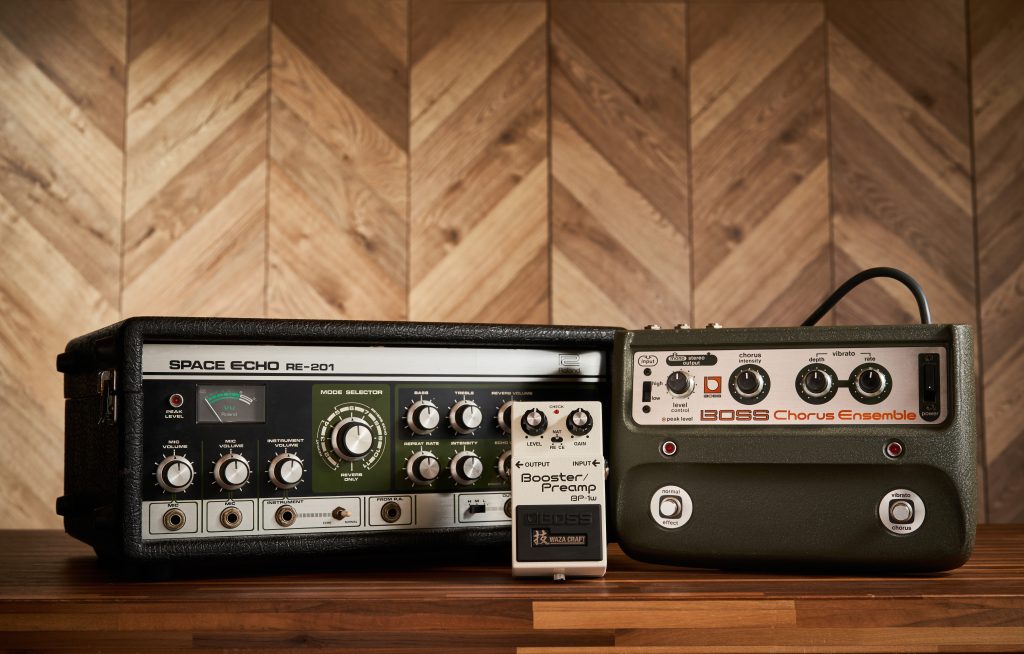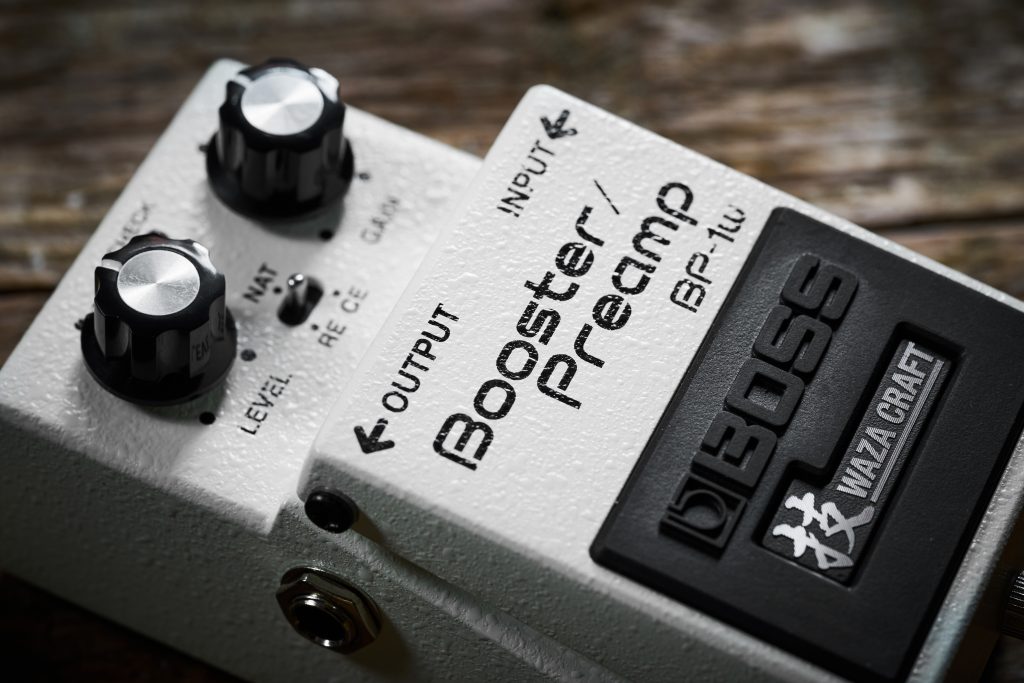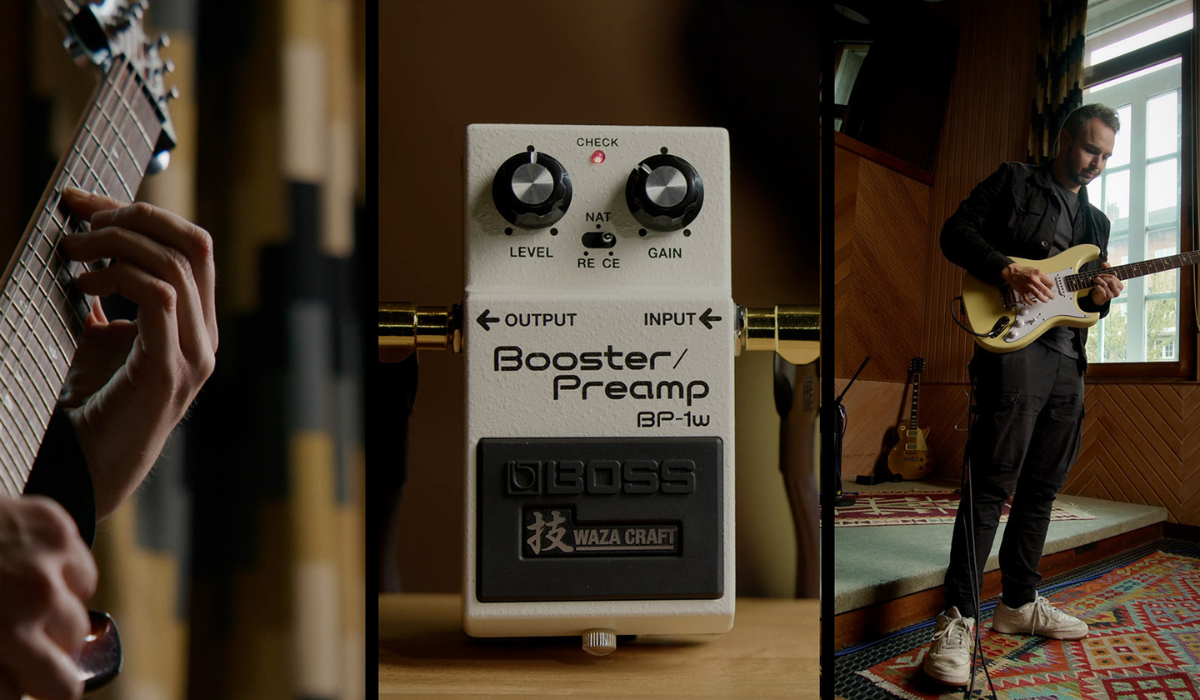Boost pedals are a straightforward type of guitar effect; their function is to increase the signal level to the amplifier. These pedals are one of the earliest effects types for guitar players. They have been around before guitar effects were even in stompbox form and have been a mainstay for guitarists for so many decades. Over that time, they’ve been continually reimagined and used in exciting ways to create a broad range of different effects. Here’s everything you need to know about boost and preamp pedals.
When to Use a Boost Pedal
Guitarists generally use boost pedals to perform lifts in particular song sections. Players often use a boost to help a solo cut through the mix, which can be helpful when competing against a rhythm guitar or keyboard.
However, that’s far from their only application. Boost pedals are also very effective overdrive accentuators. Running a boost before an overdrive can be a great way to get an alternative drive texture. A boost can slam the front end of an overdrive and create a thick drive tone, perfect for alternative textures. This is the same way a high-output active pickup will drive a pedal harder by collapsing the pedal’s gain stage more aggressively.
"Running a boost before an overdrive can be a great way to get an alternative drive texture."
In the same way, a boost pedal can create more gain from an amplifier at lower volume levels. Running a boost into an amplifier’s front end increases the gain level of the amp, not just the volume. In this context, a boost pedal is an alternative to an overdrive to create organic, natural-sounding classic rock drive tones. Alternatively, boost pedals can increase output and refine the sound of an amplifier. To understand this, let’s look at the origins of the boost pedal and some early examples of its application.

Different Types of Boost Pedals
Boost pedals are mainly divided into two categories: clean boost and treble boost. A clean boost pedal’s purpose is to increase decibels without tonal coloration. Thus, the pedal will not impact the amplifier’s gain stage.
A treble booster traditionally boosts more than just treble. These pedals will boost mids and upper mids. This boost pedal type adds tonal coloration to the guitar sound. Think of it in many ways as a fixed EQ pedal and boost. These boosts have far more applications and work as overdrives, preamps, and second drive voicings.
"In the case of the BP-1W, the level and gain controls are very interactive, in the same way they would be on an amplifier."
Boost Pedal Controls
The controls of a boost pedal vary significantly between different models. Many simply have a level control. This can be the same for a clean boost or a treble boost. Often the EQ boosting properties of the pedal will remain fixed. In the case of a clean boost and boost pedals with a separate gain control, such as the BOSS BP-1W, the level will increase the decibel output of the pedal.
The gain control will add grit and a classic analog-sounding drive to your tone. In the case of the BP-1w, the level and gain controls are very interactive, in the same way they would be on an amplifier. You can reduce the level to emphasize greater gain and vice versa.
Some boost pedals can double as preamp pedals and include an EQ section. The rare BOSS FA-1 FET provided bass and treble controls for basic tone shaping. Other boost pedals, like the BP-1w, have a simple switch for global EQ voicings. It switches between a natural flat response, the preamp qualities of a RE series Space Echo, and the preamp qualities of the CE-1.

Differences Between Boost and Preamp Pedals
A boost pedal can work as a preamp/EQ pedal to help saturate and shape the guitar tone differently than the amplifier’s natural EQ. However, a preamp pedal can do this often to a greater level of tweakability. Bass players often favor these pedals going into the front of a clean, flat EQ Class-D bass amplifier to deliver a stack-like voicing.
"A boost pedal can work as a preamp/EQ pedal to help saturate and shape the guitar tone differently than the amplifier's natural EQ."
Does a Preamp Pedal Improve Sound?
Preamp pedals offer expanded tone shaping and alternative tonal options to those of your amplifier. Including a preamp pedal in your effects chain broadens your tonal palette.
Boost Pedal in the Signal Chain
A boost pedal traditionally goes in the effects chain running into the front of an amplifier. With a tube amp, the boost will increase the amp gain and output volume. It still boosts your signal but will alter and saturate the guitar tone, adding characteristics beyond a mere volume boost.
It can be positioned in several different places on the pedalboard to create different results. At the end of the pedal chain (after overdrives and distortions), it will offer the cleanest and clearest boost to the guitar signal. Positioned ahead of overdrives, it will be a second voicing to the drive pedal, collapsing the gain stage and creating a saturated drive tone.
"At the front of an effects chain, the EQ and gain settings of the preamp will affect every pedal in the chain."
Preamp Pedal in the Signal Chain
At the front of an effects chain, the EQ and gain settings of the preamp will affect every pedal in the chain. This is similar to an active guitar with built-in EQ controls. At the end of the pedal chain, a preamp pedal becomes an extension of the amplifier preamp, shaping the overall tone of all effects before they hit the amp.

Tone-enhancing Tools
Both boost and preamp pedals are versatile tone-enhancing tools that open up many tonal possibilities. From simple solo boosting to amp revoicing to altering the tonal characteristics of your favorite overdrive, both pedal types are crucial for any guitarist looking to expand and shape their sound.






